So Many Factors, So Many Options
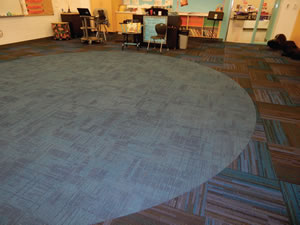
PHOTOS COURTESY OF SCOTT BERMAN
School districts seeking the right flooring must weigh factors such as upfront and life-cycle costs, durability, and maintenance requirements. That’s just part of the equation. Other factors include the need for flexibility in order to accommodate different lessons and room uses, flooring for a variety of spaces in a school or district, as well as aesthetic appeal. Then there’s green — and all that in environments that take a pounding every single day.
Districts tackle their flooring challenges in countless ways based on local conditions, needs, budgets and buildings. Take for example, Parsippany-Troy Hills Schools in New Jersey, where Tom Gaveglio, supervisor of Buildings & Grounds, recently described a series of flooring renovation projects — Mannington vinyl tile in a high school office where work stations had changed over the years, Mohawk carpet tile on the second floor of an administration building, and a Herculan poured system in a middle school gymnasium. There were differing twists and turns in the recent projects, Gaveglio notes, such as the removal of old asbestos-laden tile beneath carpeting, and sealing concrete to prevent drainage issues before pouring the sports floor, but also a common goal: ease of maintenance and repair in buildings across the bustling district.
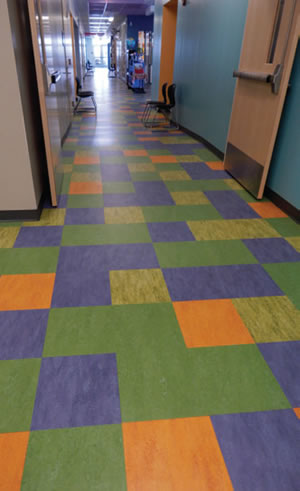
PHOTOS COURTESY OF SCOTT BERMAN
In another sense, how such flooring demands are met tells a story about the varying demands and continuing changes. Take for example, the Coventry Local Schools district in Akron, Ohio, where new flooring is part of a $30-million bond-financed set of renovation and new construction projects at the consolidating district. According to Jon Hibian, director of Facilities, flooring work includes recently replacing a hodgepodge of flooring types in a middle school with vinyl composition tile (VCT) that complements expanses of attractive terrazzo left intact, and streamlining flooring types and thus, maintenance procedures, at a high school by installing Armstrong VCT in 15 classrooms and other spaces.
The district is also installing a poured sports floor in the high school’s new gym — that along with other changes, such as installing tile in hallways and in many classrooms, is readying the building for when it becomes an elementary school in 2016. At that time, Coventry will open a $21-million high school now being constructed — renovations that include flooring and many other features account for the remaining $9 million — where, Hibian adds, officials are considering terrazzo for high-profile areas such as the main hall and cafeteria.
In another case, Champaign Unit 4 Schools, in Illinois, faced some similar, and some different challenges, for flooring when its $18-million Carrie Busey Elementary School, a LEED Gold building, was constructed in 2012. The school went with a functional variety: vinyl enhanced tile and Marmoleum in hallways, rubber on stairs, a sports floor in the gym, heatsealed Gerflor in art rooms and bathrooms, walk-off carpet tile and mats at entrances.
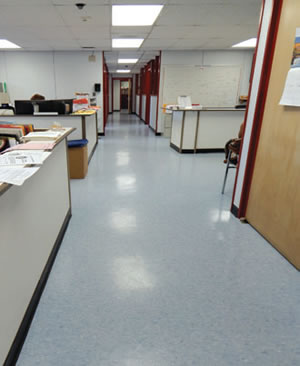
PHOTOS COURTESY OF SCOTT BERMAN
Schools’ Choice. Decisions about flooring types need to be based on a number of factors. One of the most important ones should be how that surface is going to be used. For example, the type of flooring that may be the best choice for the hallways most likely will not serve as well in the gym or library or offices. Of course, there are also considerations such as cost, maintenance, acoustics and sustainability that need to enter into the process.
In another detail, music room floors are fitted out with carpet tile — it’s Interface, and incidentally, contains recycled content and has a low-VOC (volatile organic compound) adhesive, Vespa reports — that has an inlaid circular pattern, which helps with manage the space during lessons. Hundreds of youngsters use the space each week and it’s held up well.
Throughout the building, the extensive use of carpet in classrooms is unusual for the district, Vespa notes: Carrie Busey has a large program for the Deaf and Hard of Hearing, and carpeting, along with other features, helps acoustics. By comparison, the district’s Booker T. Washington STEM Academy, built one year before Carrie Busey, has tile on classroom floors, with carpet used, again with acoustics in mind, in the aforementioned music rooms, the administrative office, and the school library.
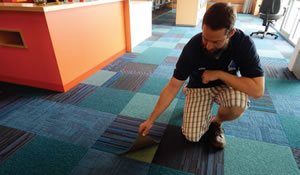
PHOTOS COURTESY OF SCOTT BERMAN
That library’s carpet squares — which a custodian demonstrated are easy to lift away and replace — are in a deep blue motif and two years out, have a pristine look, aside from tiny bits of tape have been placed here and there to direct students when in the space. Indeed, flooring throughout the school display vibrant, rich hues and color schemes change to indicate grade levels, and the district worked with the designer on this aspect. It makes for a colorful, attractive palette.
Indeed, providing colorful floors that stand up to wear is a common goal for districts, as was the case several years ago at Palmyra High School in Pennsylvania, according to manufacturer and installer Stonhard. Stonhard says the school was faced with replacing deteriorating floors in halls, its cafeteria and locker room while wanting “something eye-catching...”. The school went with a seamless flooring product with wear, slip and stain resistance, and in a range of colors — including a bold three-color pattern in a dining area, that adds visual appeal.
Such a range of use for resinous flooring systems is a sign of the times, according to John Wagner, senior architectural engineer for Stonhard. He argues that because such systems are durable, easy to clean and maintain, they have “reached a point to where (they are) almost exclusively specified in restroom, locker room and back-of-house food service applications.” One end result, adds Wagner: “a much lower life-cycle cost compared to the traditional flooring types.”
On a different tack, another manufacturer is noting a trend in terms of how schools are making their choices: According to Tandus Centiva’s John Sumlin, national sales vice president of Education, the common low-bid-wins model “is going away,” Sumlin explains that among other things, “we are seeing more pre-qualification discussions... Schools are talking to each other about what works.” Sumlin continues that “experimentation is no longer the norm with constructors or materials; we cannot afford it!”
The Champaign Unit 4 district, for example, considers life-cycle costs during a project’s design phase, Vespa explains, but as with other districts nationwide, budgetary give-and-take often dictates decisions. But that being said, the district takes into account factors such as maintenance, likely timeframes for replacement, whether grant money is available to help offset first cost, and others, she says. In another sign of the times, Vespa is also noting more interest in sustainable flooring materials. No surprise there, yet such materials are also being seen as part of a bigger whole: as part of an holistic approach to create better working and learning environments, Vespa adds.
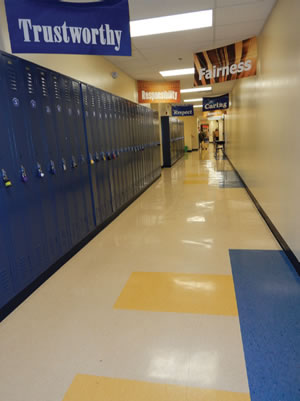
PHOTOS COURTESY OF SCOTT BERMAN
Given all the factors and demands at play, it’s a high bar for a district. And the effort to reach that bar starts under your feet.
Some takeaways about the process of selecting new flooring:
- Think through how flooring selections will work with features such as moveable walls, as Vespa suggests, and in a broader sense, what and how your school is teaching and learning.
- Streamline. Among others, weigh the factors of maintenance procedures, supplies and equipment as well as purchasing and replacement. Cut out guesswork.
- Ask plenty of questions of designers, suppliers, custodians, staff, and your counterparts in other districts: about maintenance and wear in particular. Ask for full-size samples for a look in its potential space. Doing so “can really tell a different story” than a small sample in a color selection book, adds Champaign’s Vespa.
This article originally appeared in the issue of .